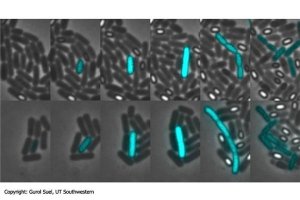Oct 29 2009
The experiment, featured on the cover of the leading weekly science journal Cell of October 30, shows that cells use chance to survive uncertainty.
 The images show bacterial colonies behaving in the same way: in the image at the top, using the natural circuit, and in the image at the bottom, using the sysnthetic circuit.
The images show bacterial colonies behaving in the same way: in the image at the top, using the natural circuit, and in the image at the bottom, using the sysnthetic circuit.
“God does not play dice,” said Einstein to explain that chance does not intervene in nature. However, researcher Jordi García Ojalvo, from the Campus of the UPC in Terrassa, has carried out an experiment, featured on the cover of the leading weekly international journal Cell of October 30 that shows that this is not the case for living organisms. The experiment is the first to succeed in creating a synthetic gene circuit that functions in the same manner as a natural live stem cell.
Why do living beings choose to function a certain way? Why do cells base their operation on certain gene circuits and not others? These questions are among the central issues of contemporary science; we need to know the answers in order to understand how living beings work and how cell imbalances cause all kinds of diseases, from cancer to autoimmune diseases. Researcher Jordi García Ojalvo, from the Campus of the UPC in Terrassa, has faced these issues by designing the first ever synthetic gene circuit that works in the same way as an in vivo natural circuit, and he has compared the two.
The experiment, carried out by the researcher in collaboration with American scientists, has shown that chance plays a very important role in living organisms. According to García Ojalvo’s study, featured on the cover of the leading weekly international journal Cell of October 30, cells rely on chance to win the game of evolution, to survive and adapt to the uncertainty of the environment in which they live. “Living beings do play dice, and they even win,” says García Ojalvo. “Cells often do not know when they will find the nutrients that will enable them to continue living and playing their role. As their future is unpredictable, they act using chance as the most effective tool for survival. Therefore, some genetic circuits are designed to behave randomly. ”
The researcher at the UPC Campus in Terrassa reached this important conclusion after designing the first ever synthetic gene circuit that has the same functions as the natural circuit of a living cell. The synthetic circuit, which is based on mathematical models and is introduced into the bacterium Bacillus subtilis, behaves in a more predictable way than the natural circuit, but is less efficient when it attempts to procure alternative nutrients in uncertain environments (these alternative nutrients are pieces of DNA that the bacteria can find in the extracellular medium).
The research of Jordi García Ojalvo was carried out with the participation of researchers Suel Gurol of the Southwestern Medical Center at Dallas and Michael Elowitz of the California Institute of Technology, both in the United States.